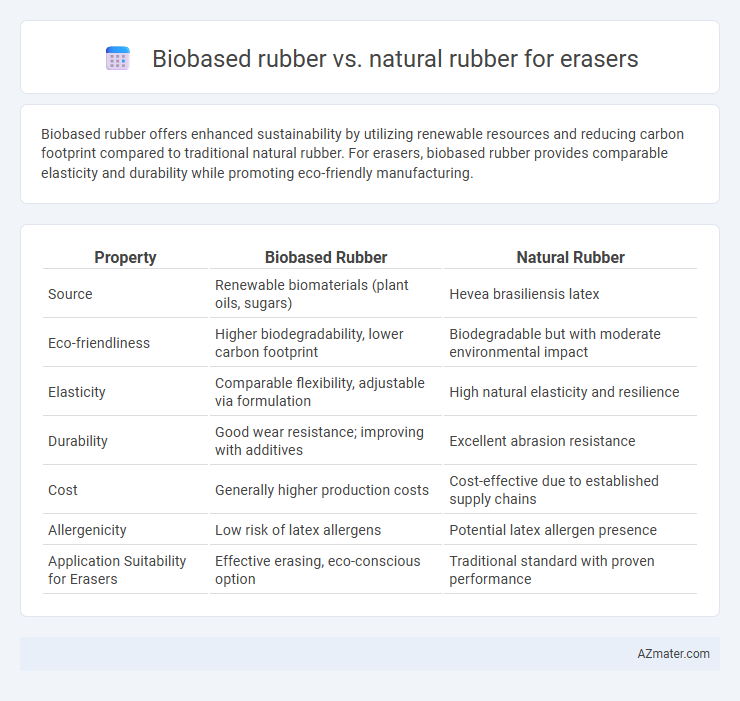Biobased rubber offers enhanced sustainability by utilizing renewable resources and reducing carbon footprint compared to traditional natural rubber. For erasers, biobased rubber provides comparable elasticity and durability while promoting eco-friendly manufacturing.
Table of Comparison
| Property | Biobased Rubber | Natural Rubber |
|---|---|---|
| Source | Renewable biomaterials (plant oils, sugars) | Hevea brasiliensis latex |
| Eco-friendliness | Higher biodegradability, lower carbon footprint | Biodegradable but with moderate environmental impact |
| Elasticity | Comparable flexibility, adjustable via formulation | High natural elasticity and resilience |
| Durability | Good wear resistance; improving with additives | Excellent abrasion resistance |
| Cost | Generally higher production costs | Cost-effective due to established supply chains |
| Allergenicity | Low risk of latex allergens | Potential latex allergen presence |
| Application Suitability for Erasers | Effective erasing, eco-conscious option | Traditional standard with proven performance |
Introduction to Rubber Types in Eraser Production
Biobased rubber in eraser production offers sustainable alternatives derived from renewable resources such as plant oils and bio-synthesized polymers. Natural rubber, sourced from the latex of Hevea brasiliensis trees, remains highly valued for its elasticity and resilience in traditional erasers. Advances in biobased rubber aim to match the performance properties of natural rubber while reducing environmental impact through lower carbon footprints and enhanced biodegradability.
What is Biobased Rubber?
Biobased rubber is derived from renewable plant sources such as guayule, dandelion, or Hevea brasiliensis, offering a sustainable alternative to traditional natural rubber harvested solely from rubber trees. This type of rubber maintains the key elastic and abrasion-resistant properties essential for eraser applications while reducing dependency on conventional agriculture and minimizing environmental impact. Advances in biobased rubber technology improve material consistency and performance, making it an eco-friendly choice for high-quality erasers.
Understanding Natural Rubber
Natural rubber, derived from the latex of Hevea brasiliensis trees, offers excellent elasticity and resilience, making it a preferred material for eraser production. Its molecular structure provides superior flexibility and durability, ensuring effective erasing without tearing the paper. Unlike synthetic alternatives, natural rubber's biodegradable properties contribute to eco-friendly disposal and reduced environmental impact.
Sustainability: Biobased vs Natural Rubber
Biobased rubber for erasers offers enhanced sustainability by utilizing renewable plant-based resources, reducing reliance on traditional natural rubber derived from Hevea brasiliensis trees, which often involve deforestation risks. The production of biobased rubber typically results in lower carbon emissions and promotes circular economy principles through biodegradability and reduced landfill waste. Natural rubber remains biodegradable but faces ecological challenges related to land use and biodiversity loss, making biobased alternatives increasingly preferable for environmentally conscious eraser manufacturing.
Performance and Erasing Efficiency
Biobased rubber exhibits comparable performance to natural rubber in eraser applications, providing similar elasticity, durability, and abrasion resistance. Erasing efficiency of biobased rubber often matches or exceeds that of natural rubber, effectively removing graphite marks without tearing or residue. Enhanced formulation with biobased polymers can improve environmental sustainability while maintaining high-quality performance standards.
Environmental Impact Comparison
Biobased rubber for erasers significantly reduces carbon footprint by utilizing renewable plant resources, decreasing dependence on fossil fuels compared to natural rubber, which is harvested from rubber trees with variable environmental effects. The cultivation of biobased rubber feedstocks often involves sustainable agricultural practices that minimize deforestation and biodiversity loss, whereas natural rubber production has been linked to habitat destruction and soil degradation in tropical regions. Biobased rubber also offers improved biodegradability, leading to lower environmental pollution in disposal, making it a more eco-friendly alternative for eraser manufacturing.
Cost and Availability
Biobased rubber for erasers often has a higher production cost compared to natural rubber due to advanced processing technologies and limited large-scale manufacturing. Natural rubber benefits from widespread availability in tropical regions, leading to lower raw material costs and more established supply chains. The cost-effectiveness and ready availability of natural rubber generally make it the preferred choice for mass-produced erasers.
Durability and Lifespan in Use
Biobased rubber used in erasers often exhibits enhanced durability due to its improved resistance to abrasion and environmental factors compared to traditional natural rubber. Natural rubber erasers, while flexible and soft, tend to wear down faster under repeated use, reducing their effective lifespan. Advances in biobased rubber formulations extend eraser longevity by maintaining elasticity and structural integrity throughout prolonged usage.
Consumer and Industry Adoption
Biobased rubber offers a sustainable alternative to natural rubber, attracting consumer interest due to its eco-friendly sourcing and reduced environmental impact in eraser production. Industry adoption is driven by increasing regulatory pressure and demand for biodegradable materials, leading manufacturers to invest in biobased rubber technologies for enhanced product differentiation. Market trends indicate a growing preference among environmentally conscious consumers, pushing companies to incorporate biobased rubber in erasers to meet sustainability goals and reduce reliance on traditional natural rubber plantations.
Future Trends in Rubber-Based Erasers
Biobased rubber is gaining traction in rubber-based erasers due to its sustainable sourcing and reduced environmental impact compared to traditional natural rubber. Advances in polymer chemistry enhance the durability and elasticity of biobased rubber, making it a viable alternative for high-performance erasers. Future trends indicate an increasing shift towards bio-derived materials driven by consumer demand for eco-friendly stationery products and stricter environmental regulations.

Infographic: Biobased rubber vs Natural rubber for Eraser
 azmater.com
azmater.com